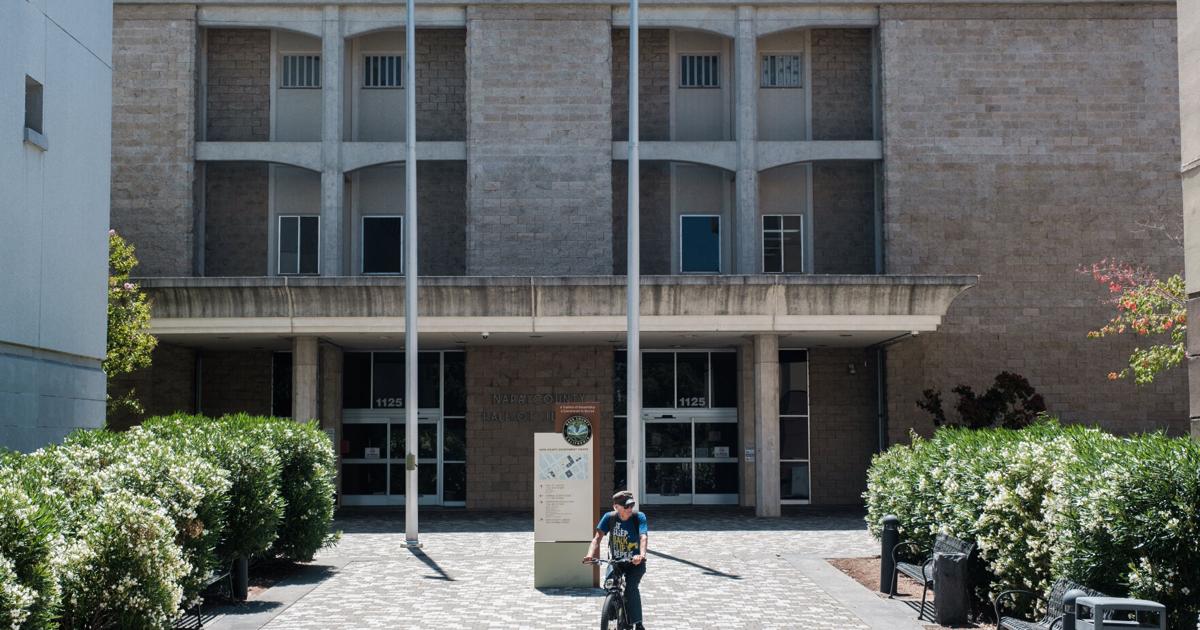The bacterium that causes Legionnaires’ disease was found in the fixtures of the building housing the Napa County Jail and on the hotel grounds. All of these are linked to the largest regional outbreak in recent years, county officials confirmed.
County spokesperson Leah Doyle Stevens said Thursday afternoon that a water sample taken from the courthouse cooling tower at 1125 Third Street in downtown Napa contained high levels of Legionella bacteria. said it was.
Support your local news coverage and the people who cover it by subscribing to the Napa Valley Register.
The county received test results from water samples in the Justice Hall on Wednesday, where it began disinfecting all parts of the building’s cooling system immediately after collecting water samples there, the county said in a follow-up statement.
Although the courthouse cooling system is believed to pose little risk of harboring Legionella bacteria, the county will continue to monitor and send samples to an outside lab for testing, with results available in a week or two. officials said.
People are also reading…
Legionella was also found in samples of decorative fountains and ponds at the Embassy Suites by Hilton Napa Valley, 1075 California Blvd. News released around 4 p.m. According to his release, the same hotel in the city of Napa where Legionella was previously found in its cooling tower. outbreak. )
Both sites where water samples were taken on July 25 had been cleaned and disinfected since last week before test results were available, county officials said.
Dr. Karen Relucio, Napa County Public Health Officer, said: County health and environmental health staff said, “We have reached out to other cooling tower facility managers to proactively remediate. ,” she said in a statement.
Napa County Public Health officials have reported that they have found the bacteria that causes Legionnaires’ disease on the premises of a Napa hotel. The day after local deaths from the disease were announced. Officials said none of the 12 local residents who contracted Legionella since July had visited the hotel.
Legionella is waterborne and can spread as an aerosol up to a mile from a contaminated water source, Relucio said last week.
Doyle-Stevens said county officials continue to monitor courtrooms, but prison inmates and county officials were not removed or moved from the compound late Thursday.
Napa County also announced the illness of a Solano County resident who is believed to have contracted the disease in Napa. reported to One of his patients later died and two are hospitalized.
County health officials confirmed the first nine cases of Legionella on 29 July and confirmed the patient’s death on 2 August. This is his first death in Napa Valley since at least 2015. The year is typical, according to health officials.
Napa County said its health and environmental division is working with a joint investigative team that includes the state’s Department of Public Health and the U.S. Centers for Disease Control and Prevention.
Legionnaires’ disease – named after the legionnaires’ disease that caused 29 deaths and about 180 illnesses at the 1976 Congress of the United States Legion in Philadelphia – a type of pneumonia caused by Legionella bacteria occurs naturally in lakes and streams, but can also be artificially propagated in warmer-water sources. Aerosolized water can come from cooling towers (air conditioning units in large buildings), hot tubs, cooling mists, decorative fountains, and plumbing systems. (Home air conditioners are not considered a threat to spread bacteria, as most units do not use water as a coolant.)
Napa County residents and workers with flu-like symptoms, cough, fever, or difficulty breathing should contact their healthcare provider as soon as possible. People can get sick by breathing in aerosolized water droplets that contain bacteria. Legionnaires’ disease does not spread from person to person and can be treated with antibiotics if detected early.
Those at higher risk of contracting Legionella include people over the age of 50, smokers, and those with chronic lung disease or a weakened immune system.
Strategies to prevent Legionella overgrowth in the home include:
• Cleaning faucets and shower heads that have not been used recently.
• Cleaning, disinfecting, and maintaining all equipment that uses water, including humidifiers, respiratory therapy equipment, showerhead and faucet aerators, water heaters, and hot tubs.
For more guidance, see CDC Preventing Waterborne Birms at Home at https://www.cdc.gov/healthywater/drinking/preventing-waterborne-germs-athome.html.
PHOTOS: This Week in Napa Valley, August 5th
Napa’s community music crawl scene returns to the porches and streets of Old Town on Sunday, where musicians and fans meet face-to-face.
Monday marked the grand opening of the Brenkel Court self-help housing project in St. Helena. The project will focus on eight regional healthcare, agricultural…
These Napa area students learned to fly for free this summer. They were enrolled in the Aviation Explorer program, sponsored by a non-profit…
Has this man ever poured a drink for you? Meet Wine Country Bartender Mark He Egan. He works full time in Napa County and…
Meet Dr. Eugene Eisenberg, a 94-year-old Napa endocrinologist who recently retired after 72 years of service.
Howard Yune 530-763-2266 or [email protected]





